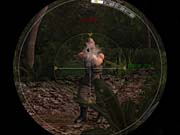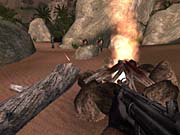Far Cry Q&A
We speak with Far Cry's producer to get the latest details on this impressive-looking first-person action game.
From its first public showing as the X-Isle tech demo to its present form as a first-person shooter, Far Cry has been a showcase for Crytek's impressive graphics engine. We heard plenty about the engine's advanced features at GDC--real-time lighting and shadows, vast view distances, and "polybump" normal mapping--but now it's time to talk about the actual gameplay. We recently spoke with Crytek producer Christopher Natsuume about the game's setting, innovative AI, and multiplayer features, as well as about what we can expect to see in the demo version of the game that will be shown next month at E3.
GameSpot: We haven't seen much of Far Cry since the last E3, except the technology demo at GDC in early March. How far along is the game right now?

Christopher Natsuume: We are currently finalizing the rough cut of all our levels. We have the vast majority of our features in the game and working. Now we just have to get them all tuned and adjusted. It's actually a very exciting time for us, because a lot of what we have been working on for so long is finally coming together.
GS: Give us a quick overview of the game's story. What are the missions like, and what sorts of challenges will the player face?
CN: Of course, the whole story is still very secret, but I can let you know the basics.
The hero is Jack Carver, a man with a mysterious past who has dropped out of society to run a charter-boat business in the South Pacific. A beautiful journalist hires him to take her secretly to an uncharted island in Micronesia, where she says that she will be doing some research. The game begins as Jack's boat is destroyed by mercenaries and he is stranded on the island. He must find the journalist, help her foil the plans of an evil doctor and his minions, and get off the island alive.
We don't really have missions in the traditional sense--you didn't want to go to the island in the first place, so you aren't in any mood to take orders from anyone. Instead, the game unfolds naturally as the player finds new things and goes new places in his search to get the heck out of there. Each place has a new challenge and some interesting secondary challenges that must be completed to move forward, but the real challenge of the game is just to stay alive, as just about everyone on the islands is out to get you.
GS: What are some of Far Cry's more distinctive gameplay elements?
CN: What we are most proud of is our mix of stealth and action gameplay. The player has a lot of control over where he goes, what he does, and how he chooses to attack his enemies. This is supported by strong stealth and action elements. Most of the game can be played either way--or in a crafty mix of the two. The game will actually respond to your play style. Because the AI enemies are designed in a systematic way, they will respond very differently to player stealth attempts, making them quite fun to play with.
GS: We saw some impressive technology in the GDC demo. Apart from sheer visual impact, are there particular ways in which the engine's graphics and physics capabilities contribute to the gameplay?

CN: Well, the obvious technology that we are exploiting is our ability to create some truly expansive outdoor environments--and all of it is real, not visual tricks and effects. If you see a beautiful island in the distance and want to swim out and see it, go right ahead, nothing stops you. If you want to try to sneak through the jungle instead of walking down the path and into the ambush, be our guest--but remember, the AI know that they can go anywhere as well! It frees the player in a way we haven't experienced in a lot of games.
This also opens the door for some very long-range gameplay. We can shoot absolutely absurd distances with some of our weapons--sometimes so far that you cannot even see the enemies you are shooting at without binoculars or a sniper scope. Even our rocket launcher has a scope on it. This gives the player a real feeling of power and control over these massive environments, and it adds a great deal of tactics to the experience.
Roaming the Island
GS: We've heard that Crytek is taking an ambitious approach with the AI. Tell us about what we can expect from the enemies in the game.
CN: We're quite proud of this, as it's essentially the core of our gameplay.

Traditionally, AI characters have been the "victims"--they hang out and wait to get shot. If you run away, they will sort of let you go. In the cases that they look for you, it is usually along a scripted path that you can avoid. Far Cry is totally different--our enemies sense you and sense the environment around them, and once they know you're there, they hunt you down like a dog. It sounds like a small change, but it's a completely different experience from other FPS games. It can really keep the player on his toes.
Furthermore, the enemies in our game are totally unscripted--they are built so they respond directly to what the player does. They actually understand the environment around them and know how to use it efficiently, no matter where the player attacks from, which allows us to give the player a great deal of freedom.
Even when the player is nowhere around, the AI have little lives of their own. They grow bored, move around, investigate noises, have conversations with each other, and do other things to keep themselves occupied. When you check them out in your binoculars, they could be doing all kinds of things, and you can plan your attack strategy around that.
GS: The parts of the game that we've seen so far have mainly taken place in large outdoor environments. What sorts of settings can we look forward to in the final game? Has it been a particular challenge to design environments that are so large?
CN: As for what the player can expect to see, we have the richest sprawling jungle islands that have ever been shipped in a game that we are aware of, which in itself is pretty cool. But we also have some incredible indoor sections as well. The levels are broken up with compounds, buildings, tunnels, old bunkers, caves, and even underground research facilities. There's a rich mix between indoor and outdoor environments for the player to explore. Each offers a different gameplay experience, from shooting a merc from 500 meters with a sniper rifle across a jungle valley to gunning down a few guards with a shotgun in a steam tunnel.
In fact, our engine doesn't separate between indoor and outdoor technology, so the transitions are completely seamless. We can have a character in a building looking out a window at a beautiful lagoon, and when he pulls out his binoculars, he can see through the window and into a room that is almost a kilometer away. And if he doesn't like what he sees, he can whip out a sniper rifle and shoot it. It's pretty neat.
As for design challenges, the core technology and our groovy CryEdit tool have made creating large environments a lot easier than you might think. The problem has been more in balancing player freedom in a large wilderness environment with long-range weapons and telling a linear story that is interesting. But we think that the results offer both a compelling story and a great deal of freedom, and that's what players really want.
GS: Tell us about the multiplayer plans for the game. Will the multiplayer maps be set in outdoor settings or in more constrained environments?

CN: It's funny, I'm actually skipping out of a multiplayer session right now to do this interview. We're testing our CTF mod today. We are also working on some other mods that we can't talk about yet, but you can be sure that the basics will be in there. Plus some special modes that showcase our AI and our massive outdoor environments, which should have a very "Far Cry" flavor.
And, like the rest of the game, we will have both sprawling and constrained environments for the multiplayer maps--often on the same map.
GS: E3 is coming up quickly. What can we expect to see of the game at the show?
CN: You can expect to have your socks knocked thoroughly off. We will have a fully playable level showing just about everything you just heard about, plus a bunch more. Dynamic music, vehicle gameplay, long-range sniping, boats, helicopters--the list goes on, but I don't want to spoil the surprise. I was just playing it this morning, and it's getting pretty cool.
GS: What's the current release schedule for Far Cry?
CN: Save space in your stocking--it'll be on shelves this Christmas.
GS: Thanks, Chris.
Got a news tip or want to contact us directly? Email news@gamespot.com
Join the conversation